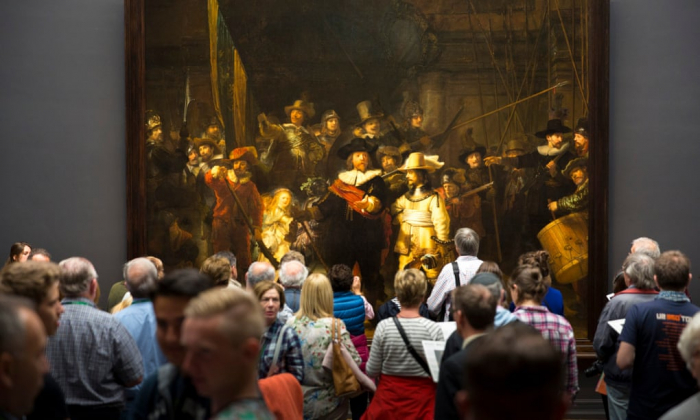The public will be invited to watch the intimate conservation process, both up close in the gallery itself and via an internet livestream, in what is believed to be the biggest ever undertaking of its kind.
Taco Dibbits said it was expected to be a slow and intricate project, which would take several years and cost millions of euros.
“It will be carried out under the eyes of the world, and people will be able to follow the conservation wherever they are, whenever they want,” the art historian, who has been head of the Rijksmuseum since 2016, said in an exclusive interview.
Completed by Rembrandt van Rijn in 1642 at the height of the Dutch Golden Age, The Night Watch, more formally known as Militia Company of District II under the Command of Captain Francis Banninck Cocq, was commissioned by the major and leader of the civic guard of Amsterdam. He wanted Rembrandt to create a group portrait of his shooting company. The artist depicted them moving out, rather than a static group as convention dictated. Its focal figures – almost life sized – are the captain and lieutenant at the centre and the girl in the background left of centre, who is bathed in light and clutching a chicken.
The painting has pride of place in the Rijksmuseum’s Gallery of Honour, which was built especially for the painting and where it sits on what Dibbits calls a “high altar”, visited by more than 2 million people a year.
In recent years, Dibbits and his colleagues had noticed deterioration in the work, which was last restored in 1975, following a knife attack by a Dutch teacher. “We continuously monitor the painting and noticed that the restoration of the 1970s had stared to discolour,” said Dibbits. “There’s a whiteish haze which appears on it, so you can’t quite appreciate it in its full glory.”
One tell-tale patch, he said, is the blanched figure of a dog on the lower right of the painting.
“Because it’s such an amazingly important painting and so many people want to see it, we feel we have to keep showing it to the public even as we’re restoring it,” he said.
An ultra white (very clear glass) chamber, 7-metres square, designed by the French architect Jean-Michel Wilmotte, is being built to encase The Night Watch and its conservators.
Firstly the experts will research the painting, mapping it millimetre by millimetre using a scanner, in a process which will take around 70 days. Using the scan, and additional imaging techniques, high-resolution photography and computer analysis, a detailed picture of the painting, from the varnish to the canvas, will be mapped. Only then will the team make a plan, determining precisely how to proceed with the restoration.
“This is a once in lifetime opportunity for the public,” Dibbits said, “not least because the materials we have now for preservation are so much better and more advanced than in the past, that it’s unlikely to happen again for the next few generations.”
Dibbits, 50, recalled what he described as the magic of seeing The Night Watch as a seven-year-old in between workers’ breaks, when it was being restored last time round.
“It was hugely exciting to see. Like every conservation, on the one hand it’s very scientific, on the other it’s very mysterious. It inspired my curiosity in the creative process, in how a work of art is born. But when the conservators were working it was hidden behind a curtain.
“This time round we decided to be transparent because the process is so pleasing to see – it’s like being able to get a view into the kitchen to see what the cook actually does.”
Hundreds of experts, including from the Rijksmuseum and the Delft University of Technology and elsewhere around the world, will be involved.
The project is not comparable in scale to the vast restoration project to restore the Sistine Chapel, which took place between 1980 and 1994. Neither is it the first public restoration project. One of the highest profile of recent years was the Musée D’Orsay’s crowd-funded restoration of Gustave Courbet’s The Artist’s Studio, between 2014-15. But it is believed to be the largest and most elaborate public restoration project ever undertaken.
Dibbits said conservators and restorers were clamouring to work on the project and insisted that they would not shy away from public scrutiny if criticisms or comments over the progress of the restoration work were forthcoming.
“We’d rather raise discussion than shy away from it,” he said. “At the same time we have to have our own plan, otherwise we’d waver.”
Conservators will be on hand to answer visitors’ questions, and regular updates on the work, such as discoveries over pigments used or changes made by Rembrandt, will be made public.
Fears that restoration work will remove the painting’s dramatic use of light and shadow were unfounded, Dibbits added. “There will be parts that will be lighter once we’ve restored it but it will be a painting that retains that dramatic contrast, as Rembrandt chose it should,” he said.
The Night Watch, its common name, is considered to be Rembrandt’s most ambitious painting and took three years to complete. It is striking for its size – over 3.5 metres in height by almost 4.5 metres in length – and its affecting use of light and shadow. But for Dibbits what makes the oil painting even more arresting is Rembrandt’s defiant breaking of the rules of portrait painting.
“What he did with this was a first in art history: he received a commission to paint a group portrait, but he painted a history scene instead, telling a story. It’s alive and moving rather than being stiff and formulaic. He’s asked to portray people, but he doesn’t make them beautiful, he just paints them as they are. He doesn’t follow the rules of art and by so doing, he advances art in an incredible way.”
The restoration process – by far the most elaborate of the 25 treatments the painting has received in its lifetime – is due to begin in July 2019. In the five preceding months, from 15 February 2019, it will be the centrepiece in the Rijksmuseum’s showcase of its entire collection of over 400 works by Rembrandt as it commemorates the 350th anniversary of his death.
Dibbits said if he needed a reminder of the contemporary resonance of the painting it was brought home to him by Barack Obama who visited the newly restored Rijksmuseum in 2014, famously delivering a statement with the masterpiece as his backdrop.
“He described it as the most beautiful backdrop he’d ever had,” Dibbits said. “He was very moved by it, calling it a tribute to humanity, because it shows us human beings as we are, with our faults and shortcomings, our joy and sadness – it’s us, and Rembrandt’s skill was to paint people just as they are.
“It stands for a deep belief in society, that we make the world together and everyone has their responsibility in that,” he added.
More about: #Rembrandt
















































